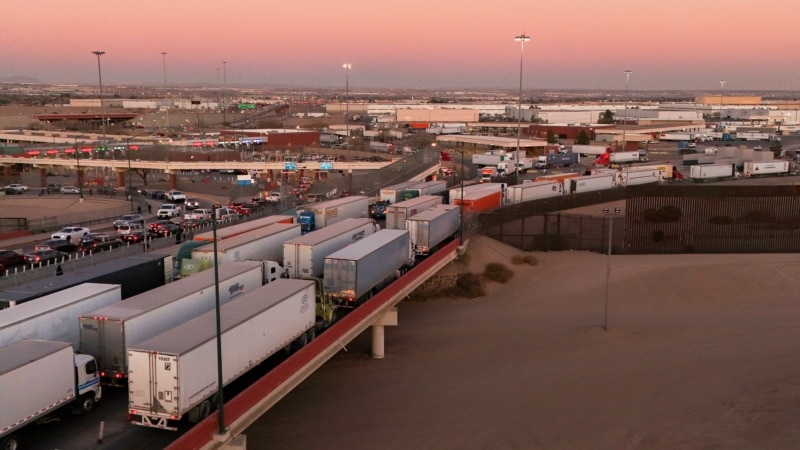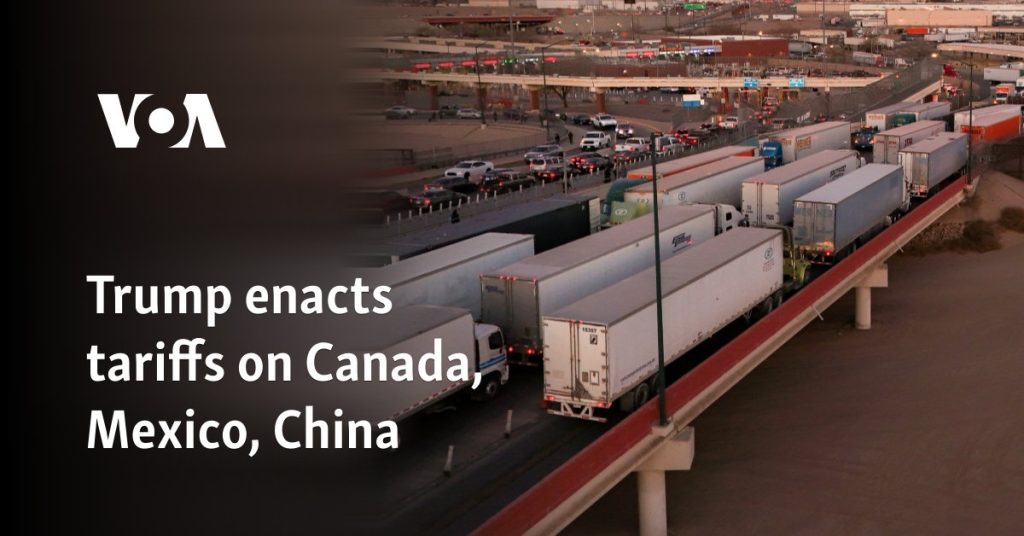
U.S. President Donald Trump signed an executive order Saturday that places 25% tariffs on imports from Canada and Mexico and 10% tariffs on goods from China starting Tuesday, the White House said.
“Both Canada and Mexico have allowed an unprecedented invasion of illegal fentanyl that is killing American citizens, and also illegal immigrants into our country,” White House press secretary Karoline Leavitt said during her briefing Friday.
Trump, who is spending the weekend at his Mar-a-Lago estate in Florida, was not scheduled to speak to reporters.
While Canadian goods will face a 25% tariff, Trump said he would tariff Canadian crude oil imports at 10%. Mexico’s energy imports are included in its 25% tariffs. For Canada alone, Trump canceled the “de minims” tariff exemption. That exception is for shipments worth less than $800.
China’s 10% would be on top of various tariffs on its goods.
Under the order, there is no process to seek an exception, but there is one to escalate the tariff rates if the countries retaliate in some way. Canada and Mexico have both said they could impose tariffs of their own on U.S. goods.
Outgoing Canadian Prime Minister Justin Trudeau said his country would respond.
“We’re working hard to prevent these tariffs, but if the United States moves ahead, Canada’s ready with a forceful and immediate response,” he posted on social media.
Meanwhile, Mexican President Claudia Sheinbaum said her country has a “plan A, plan B, plan C for whatever the United States government decides.”
Tariffs could backfire
China, Mexico and Canada account for more than one-third of the goods and services imported into or bought from the United States.
Some economists warn that the tariffs could backfire.
Imports from Mexico and Canada make up around 3% of U.S. GDP, while exports make up around 2.5% of U.S. GDP, said Brad Setser, a senior fellow at the Council on Foreign Relations
A 25% tariff on Mexico and Canada amounts to a “tax hike on imports from those countries” and will “have an immediate and negative impact on the U.S. economy,” he told VOA. “It’s a strategy for shrinking the U.S. economy.”
Trump has long threatened to impose tariffs to pressure countries to help his administration stop illegal immigration and the smuggling of chemicals used for fentanyl. He has pledged to use tariffs to boost domestic manufacturing and has praised its use as an effective economic policy.
Trump believes that “tariffs are a great source of leverage,” and that he will “convince Canada and Mexico to make big concessions under the threat of tariffs,” Setser said. “But these measures are going to be pretty costly to the U.S.”
Trump acknowledged that the tariffs might cause a “short-term disruption” for consumers but said it would lead to a long-term benefit for U.S. manufacturing.
“Tariffs don’t cause inflation,” he said. “Tariffs cause success.”
The president had vowed Friday to impose sweeping tariffs on semiconductors, pharmaceuticals, steel and aluminum, and oil and gas.
“All forms of medicine and pharmaceuticals,” Trump said. “And we’ll be doing, very importantly, steel, and we’ll also be doing chips and things associated with chips.”
Trump warned he would “absolutely” place tariffs on goods from the European Union.
“They’re treating us so badly,” he said.
In imposing the tariffs, he invoked the International Emergency Economic Powers Act. The White House said Saturday the act was needed because of “the extraordinary threat posed by illegal aliens and drugs, including deadly fentanyl, constitutes a national emergency.”
Free trade agreement
During his first administration in 2018, Trump negotiated and signed the United States-Mexico-Canada free trade agreement, in part to narrow the United States’ big trade deficit — the gap between what it sells and what it buys — with its neighbors. He once called the deal “the fairest, most balanced and beneficial trade agreement we have ever signed into law.”
However, the U.S. deficit in the trade of goods with Mexico has widened from $106 billion in 2019 to $161 billion in 2023, according to government data. The trade gap in goods with Canada has also increased, from $31 billion in 2019 to $72 billion in 2023.
“He’s now acting like his deal caused a disaster needing an emergency fix,” said Derek Scissors, a senior fellow at the American Enterprise Institute.
There’s no justification for high tariffs on Canada, a market economy that’s not in the top five of U.S. trade deficits, Scissors said. “Fentanyl shipments across the Canadian border are tiny,” he added.
Fentanyl and illegal migration are justifications for border restrictions on Mexico, Scissors said. However, tariffs “don’t stop illegal immigration and probably encourage it by threatening jobs in Mexico.”
Kim Lewis contributed to this report. Some information for this report was provided by The Associated Press, Reuters, and Agence France-Presse.







